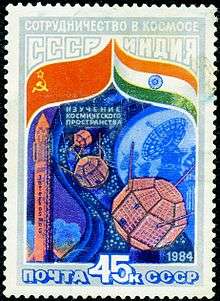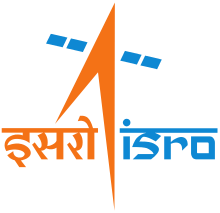Bhaskara (satellite)
Bhaskara-I and II were two satellites built by the Indian Space Research Organisation that formed India's first low orbit Earth Observation Satellite. They collected data on telemetry, oceanography and hydrology. Both satellites are named after ancient Indian mathematicians Bhāskara I and Bhāskara II.[2]
| Mission type | Experimental Remote Sensing Earth Obsservation Satellite |
|---|---|
| Mission duration | 10 years (Re-Entered in 1989)[1] |
| Spacecraft properties | |
| Spacecraft type | Unmanned |
| Manufacturer | |
| Launch mass | 444 kilograms (979 lb) |
| Power | 47 watts |
| Start of mission | |
| Launch date | 7 June 1979 IST |
| Rocket | C-1 Intercosmos Launch Vehicle |
| Launch site | Kapustin Yar |
Bhaskara-I
Bhaskara-I, weighing 444 kg at launch, was launched on 7 June 1979 from Kapustin Yar aboard the Intercosmos launch vehicle. It was placed in an orbital Perigee and Apogee of 394 km and 399 km at an inclination of 50.7°.[3] The satellite consisted of-
- Two television cameras operating in visible (600 nanometre) and near-infrared (800 nanometre) and collected data related to hydrology, forestry and geology.
- Satellite microwave radiometer (SAMIR) operating at 19 and 22 GHz for study of ocean-state, water vapour, liquid water content in the atmosphere, etc.
- An X-ray sky monitor operating in 2-10 keV energy range, to detect transient X-ray sources and monitor long term spectral and intensity changes in the X-ray sources.
Bhaskara-II
| Mission type | Experimental Remote Sensing Earth Obsservation Satellite |
|---|---|
| Mission duration | 10 years (Re-Entered in 1991)[4] |
| Spacecraft properties | |
| Spacecraft type | Unmanned |
| Manufacturer | ISRO |
| Launch mass | 444 kilograms (979 lb) |
| Power | 47 watts |
| Start of mission | |
| Launch date | 20 November 1981 IST |
| Rocket | C-1 Intercosmos Launch Vehicle |
| Launch site | Volgograd Launch Station |
The satellite provided ocean and land surface data. It orbited at 541 x 557 km with inclination of 50.7°.
One of two onboard cameras malfunctioned, however it sent back more than two thousand images. Housekeeping telemetry was received until re-entry in 1991.[5]

See also
References
- "Bhaskara-I : ISRO". Archived from the original on 20 November 2012. Retrieved 3 April 2014.
- Bhaskara NASA 16 September 2017
- Bharat-rakshak.com Indian satellite systems Archived 16 May 2007 at the Wayback Machine
- "Bhaskara-II : ISRO". Archived from the original on 12 July 2019. Retrieved 10 January 2020.
- "Earth Observation Satellite". Archived from the original on 21 January 2013. Retrieved 25 February 2013.

